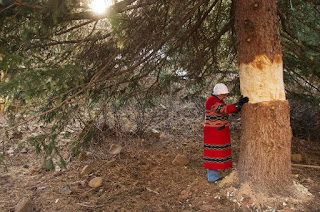By Brandi Denison
This year, the Capitol Christmas Tree, or the People’s Tree, is a 73-foot Englemann Spruce Tree from the White River National Forest in western Colorado.
 |
| Photo by Cyrus McCrimmon, The Denver Post |
The tradition of the Capitol Christmas Tree began in 1964, when the House Speaker John W. McCormack located a live Christmas tree on the Capitol lawn. This tree remained for three seasons until it died. In 1970, the Capitol Architect requested another tree from the National Forest Service. Since then, the Forest Service has provided this tree annually. The trees have come from all over the nation, with two other trees from Colorado.
The cutting ceremony of this year’s massive tree was an entanglement of capitalism, Germanic winter celebrations, and Native American ceremonial traditions. Forest Service rangers, Ute elders from Colorado, Utah, and New Mexico, Junior Miss Ute Mountain, Santa Claus, and several observers attended the cutting of the tree on November 2.
In this private ceremony, Ute Elders blessed the tree in the "Sun Dance Way." Bradley W. Hight, who is the vice-chairman of the Ute Mountain Ute Tribal Council told Elizabeth Flock of the US News & World a little about this ceremony, indicating that trees are special to the tribe because they represent "strength, medicine, food, and shelter." However, on the specifics of the ceremony, he said: "I can't talk to you about that. It's kind of secret because it only belongs to us. The Ute Tribe are the only ones who know. . . not even the Secret Service knows."
In this private ceremony, Ute Elders blessed the tree in the "Sun Dance Way." Bradley W. Hight, who is the vice-chairman of the Ute Mountain Ute Tribal Council told Elizabeth Flock of the US News & World a little about this ceremony, indicating that trees are special to the tribe because they represent "strength, medicine, food, and shelter." However, on the specifics of the ceremony, he said: "I can't talk to you about that. It's kind of secret because it only belongs to us. The Ute Tribe are the only ones who know. . . not even the Secret Service knows."
 |
| Photo by Cyrus McCrimmon, The Denver Post |
After hearing about this secret ceremony, I initially thought that the intersections of capitalism (demonstrated by the presence of Santa Claus), the German tradition of bringing evergreens into the home on Winter’s Solstice, and the secret Ute ceremony create an uncontested display of religiosity, one that is thoroughly American and securely rooted in the pastiche of Western sensibilities. In other words, I figured that the merger of American Indian ceremonies with the traditional Christmas Tree cutting was a way for non-Indians to negotiate the ambiguity of being a society that values both the non-establishment clause and public displays of religion. This is another example, I thought, of what Philip Deloria has termed "Playing Indian."
Further reflection and reading, though, led me to think about the Ute Nation's agency in the ceremony. Rather then being an appropriation of Ute spirituality to negotiate the secular-religiosity of Christmas, the secret ceremony became an opportunity for the Utes to announce their continued presence in and relationship with Colorado's National Forests. From the US Department of Agriculture website, the Ute Tribes used this opportunity to let non-Indians know that:
Additionally,Gary Hayes, Chairman of the Tribal Council, revealed that part of the purpose the secret ceremony was to bring unity to Washington. With the Christmas tree being lit by John Boehner at the beginning of the fiscal cliffs negotiations unity was (and perhaps continues to be) an elusive goal. Yet, even as the United States government and its citizens are grappling with two very serious and divisive issues (the national budget and gun control), the 73-foot Christmas tree presides over Washington through the Christmas season, having started it's 5,000 mile journey with a secret Ute ceremony.
This might be an instance of "playing Indian," but it is also an example of an American Indian Nation participating in a national dialogue through the available channels.
Further reflection and reading, though, led me to think about the Ute Nation's agency in the ceremony. Rather then being an appropriation of Ute spirituality to negotiate the secular-religiosity of Christmas, the secret ceremony became an opportunity for the Utes to announce their continued presence in and relationship with Colorado's National Forests. From the US Department of Agriculture website, the Ute Tribes used this opportunity to let non-Indians know that:
- The Tree is on Ute aboriginal lands shared by other migrating tribes who used the forest;
- The Tree is a sentinel, a landmark in the forest;
- The Tree is strength to the Ute people;
- The Tree has provided medicine and food;
- The Tree has given wood for fire and shelter from the night;
- The Tree has stood proudly for the Ute people and their lifeway.
Additionally,Gary Hayes, Chairman of the Tribal Council, revealed that part of the purpose the secret ceremony was to bring unity to Washington. With the Christmas tree being lit by John Boehner at the beginning of the fiscal cliffs negotiations unity was (and perhaps continues to be) an elusive goal. Yet, even as the United States government and its citizens are grappling with two very serious and divisive issues (the national budget and gun control), the 73-foot Christmas tree presides over Washington through the Christmas season, having started it's 5,000 mile journey with a secret Ute ceremony.
This might be an instance of "playing Indian," but it is also an example of an American Indian Nation participating in a national dialogue through the available channels.
 |
| AP Photo, J. Scott Applewhite |

No comments:
Post a Comment